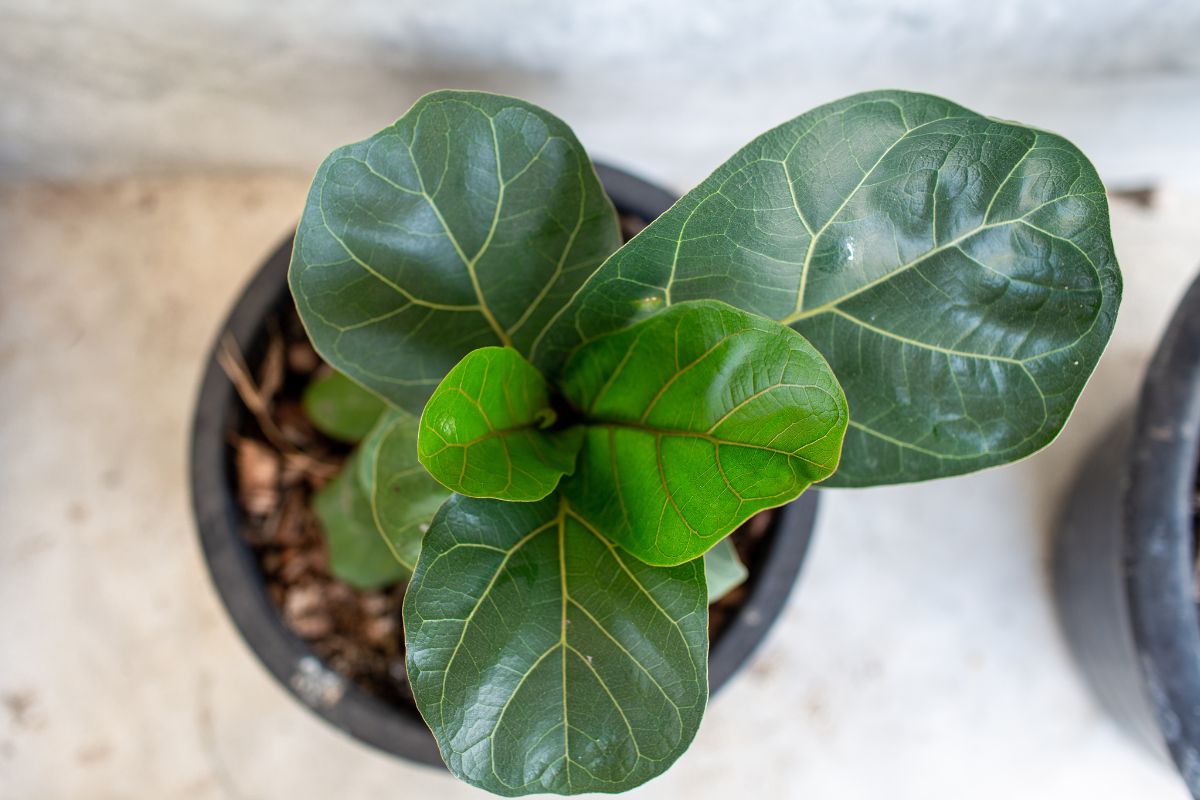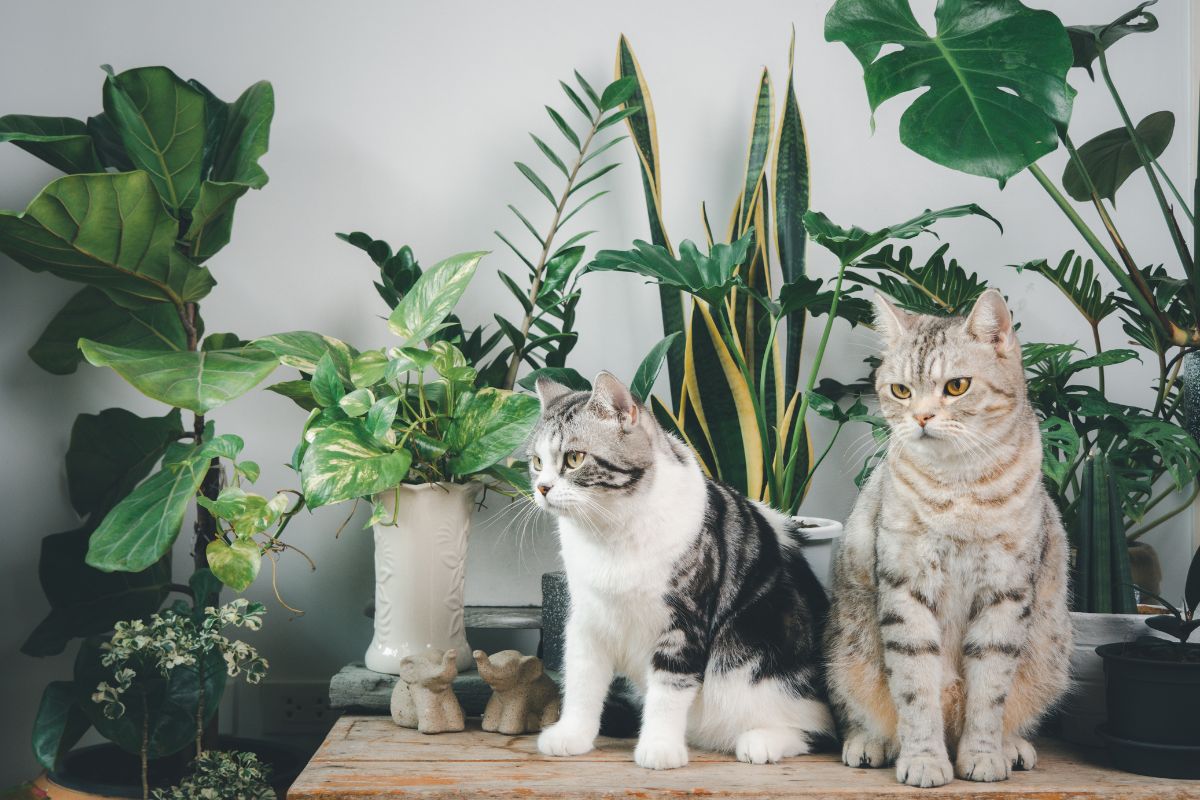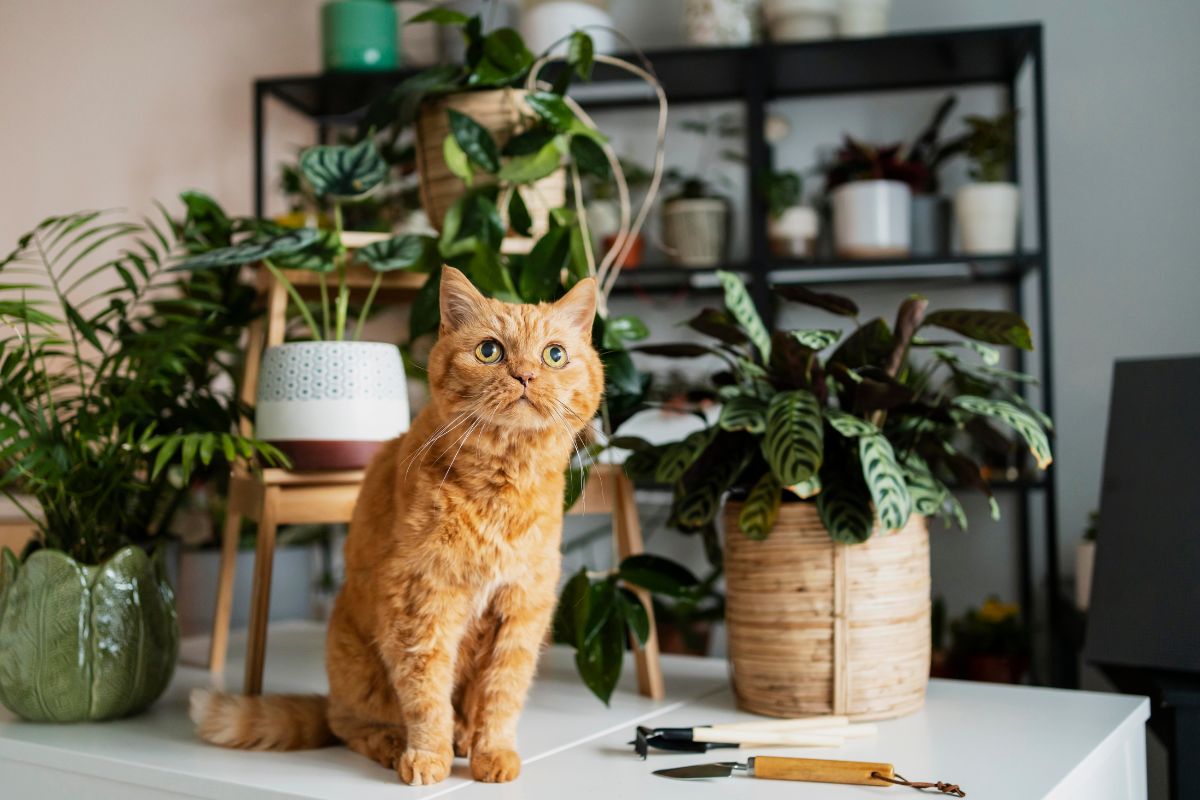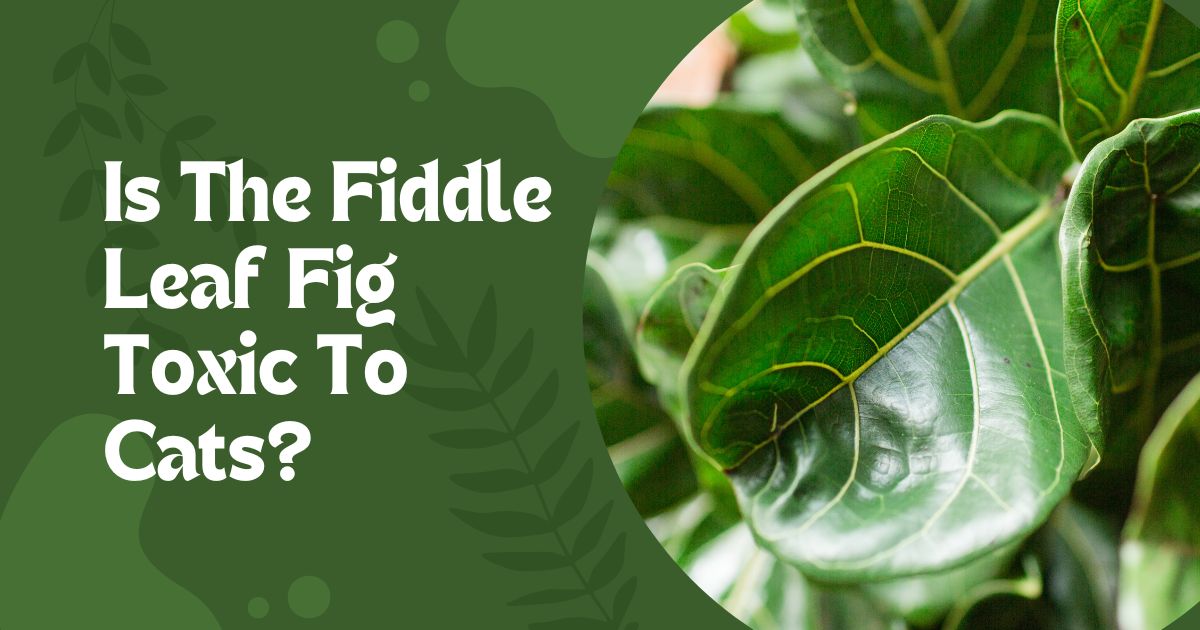The Fiddle Leaf Fig
Is the fiddle leaf fig toxic to cats? Although fiddle leaf figs make stunning indoor plants, they can harm cats. The plant’s insoluble calcium oxalate crystals, which resemble tiny needles, can have harmful side effects on your cat, including mouth irritation, frequent drooling, and difficulty eating.
Keeping fiddle leaf figs outside your house is preferable because they harm cats. Continue reading to learn more about fiddle leaf figs’ toxicity to cats.

Are Fiddle Leaf Figs Toxic to Cats?
Cats should not consume fiddle leaf figs since they can cause fatal poisoning. Ingestion of fiddle leaf figs can result in oral irritation, extreme burning of the mouth, tongue, and lips, excessive drooling, vomiting, and even difficulties swallowing.
Other symptoms include excessive drooling and excessive burning of the mouth and tongue. Ingestion of fiddle leaf figs has the same negative consequences on canines as on other animals.
Which Parts of the Plant are Toxic to Felines?
The fiddle leaf fig’s component, insoluble calcium oxalate, is responsible for the plant’s toxicity. When ingested, these tiny crystals, which appear like needles, lodge themselves in the mouth, throat, and stomach of a person or animal. Because of this, cats, dogs, and even people should not consume fiddle leaf figs because they are poisonous.
These crystals are almost anywhere on the plant, even on the stems and leaves of the plant. Other types of houseplants also contain this potentially harmful substance. Numerous houseplants contain insoluble oxalates discovered on the leaves, stems, and even the plant’s sap. Here are some other plants that are harmful for the same reason:
- Arrowhead
- Calla lily
- Peace lily
- Chinese evergreen
- Dieffenbachia
- Elephant’s ear
- cat in the garden
Although these are not the only types of houseplants that contain this potentially harmful substance, they are among the most typical. You may quickly determine whether or not the houseplant you have at home has insoluble calcium oxalate crystals by searching online that is particular to your plant.
Signs and Symptoms of Fiddle Leaf Poisoning
Clinical indications of fiddle leaf poisoning in cats may be evident shortly after ingestion, as biting into the plant releases needle-like oxalate crystals that pierce the feline’s tissues. This can occur because the crystals come out when chewing the plant. The cat may start pawing at its face, drooling heavily, or foaming at the mouth.
The feline’s face, lips, and tongue may likely expand, in addition to the upper airways, making breathing difficult. If the kitty consumes the plant foliage, notwithstanding the discomfort it causes to the mouth, it can vomit to clear the body of the poison you cannot digest.
What to do if Your Cat Eats a Fiddle Leaf Fig
It is interesting learning about fiddle leaf fig cats’ treatments. You must get in touch with your veterinarian as quickly as possible if you discover that your cat has consumed a fiddle leaf fig. If you do not have access to a veterinarian now, you should contact the ASPCA.
When your cat eats fiddle leaf fig, and you are treating it, rinse out its mouth with distilled water. This is part of the treatment process. The filtered water will reduce the amount of oral irritation the cat has and prevent it from swallowing any other toxins.
In addition, give the cat a drug that induces vomiting. An emetic will force your cat to throw up any plants that it has not digested so that you can remove them from the cat’s body. Activated charcoal is another option your veterinarian may suggest to prevent your cat from absorbing the plant’s toxic compounds.
If the situation is extreme, the veterinarian may also decide to give the patient Kapectolin or Sucralfate.
Treatment of Fiddle Leaf Poisoning in Cats
The treatment for fiddle leaf poisoning in cats involves removing the plant from the feline to stop any additional ingestion of the toxin and removing the plant from the feline’s environment. Distilled water will rinse the cat’s mouth as a preventative measure against oral irritation.
You will likely give an emetic medication to the cat to induce vomiting and expel any undigested plant matter from the upper digestive tract of the animal. The veterinarian can provide your cat with activated charcoal, a universal antidote for plant toxicity if it has not already vomited.
The body will not be able to absorb more plant compounds since the activated charcoal will bind with the harmful toxin. Suppose the stomach has irritation due to the consumption of the fiddle leaf plant. In that case, the veterinarian may choose to administer Kapectolin, a medication that produces a thick coating on the stomach wall.
The veterinarian may administer sucralfate to lower the amount of acid produced by the stomach and to prevent excessive stomach acid from corroding the stomach’s mucosal layer.
With the acid in the stomach, sucralfate forms a coating similar to a paste that serves as a barrier between the stomach’s contents and soft tissues. Because the cat’s fluid levels are likely to drop dramatically due to vomiting and diarrhea, the treatment for the feline may end with IV fluids intended to restore their hydration.
Plants That are Pet-Safe
The most effective method for preventing harm to your cat is to choose houseplants that are not toxic to cats. Even though many houseplants contain insoluble calcium oxalate, which makes them hazardous for cats to consume, other substances also have the potential to be poisonous.
The following is a list of fully risk-free houseplants to keep in a household with dogs, cats, or any other kind of animal.
- African violet
- Baby tears
- Bird’s nest fern
- Boston fern
- Bromeliad
- Calathea orbifolia
- Date palm
- Friendship plant
- Gloxinia
- Parlor palm
- Polka dot plant
- Ponytail palm
- Rattlesnake plant
- Spider plant
- Staghorn fern
- Venus flytrap
- Watercolor peperomia
Any of these plants will not harm your cat and dog. Plus, they are attractive and unusual to display in any home.

The Different Classes of Plant Toxicity
There are four classifications for toxic plants, ranging from extremely to only moderately hazardous to humans.
Toxicity Class 1
This denotes a significant level of toxicity that can lead to severe disease or even death. If you come into touch with a Class 1 plant, you risk falling into a coma and suffering substantial damage to your organs and liver.
Some examples of plants that fall into this category include (but are not limited to) monkshood, belladonna, oleander, mistletoe, hemlock, etc. Many of these plants produce deadly poisons for various purposes. Don’t mess with them! (Many of these plants are stunning to look at, but they also pose significant health risks.)
Toxicity Class 2
Consuming could result in a mild ailment, such as nausea, vomiting, or diarrhea. This level of toxicity is class 2. Plants such as alder, columbine, umbrella plant, juniper, and several varieties of snowdrops are all examples of plants that fall under this category.
Toxicity Class 3
You can find oxalates in high concentrations in these plants, and they have the potential to irritate both the skin and the digestive tract. Oxalates are the next class where the sap contains oxalate crystals, which can induce drooling and respiratory issues if consumed.
In this particular scenario, you would not want your dog, cat, or child to consume any plant belonging to Class 3. Although the sap of a fiddle leaf fig does include calcium oxalate crystals, the concentration of these crystals in the sap is not nearly as high as it is in the sap of many other plants that fall into this group.
The arrowhead plant, the calla lily, the elephant ear, the alocasia, the philodendron, and the monstera plant all fall into the toxicity Class 3 category.
Toxicity Class 4
Dermatitis is usually in plants under class 4 toxicity. Because these plants contain some oxalates, ingestion of the plant will result in irritation of the mouth and lips, and contact with the sap of the plant can cause skin irritation and rashes on those who come into contact with it.
The species of ficus lyrata cat known as fiddle leaf figs, as well as several other species of ficus, such as the rubber tree and the weeping fig, as well as ash, ginkgo, walnut, and plumeria, belong to this category.
How to Make Your Fiddle Leaf Fig Pet-Safe
The best way to ensure that your fiddle leaf fig is safe for pets is to keep them away from it at all times. Typically, this entails putting a violin in a room your pets cannot enter or placing it on a shelf too high for your cat or dog to achieve. (This could be challenging to accomplish with larger plants, but it’s a good choice if you can find a way to make it work.)
The use of high pots, stools, and plant stands can be a choice that is both practical and visually beautiful. You can use baby gates or furniture to block off your fiddle, which can also work well with certain pets. One more useful strategy is to use something to frighten your pets.
A great approach to accomplish this is to make your pet cat or dog averse to the smell of your instrument. Cats, in particular, repel the scent of citrus (dogs aren’t fans of it either), so you can put a little orange or lemon essential oil around the rim of the pot, or scatter some citrus peels on the surface of the soil, to deter cats in particular.
Dogs are also not fans of the smell of citrus. Applying a small amount of oil scented with lavender or rosemary on the edge of the pot is another option. If you want to deter dogs from digging, try covering the soil with pepper or soaking a few cotton balls in clove oil and putting them on the surface of the dirt.
However, you shouldn’t put any liquid repellants or essential oils straight into the soil because doing so can cause a chemical burn on the roots of your plants. You can also take measures to train your pet to avoid your violin by following the appropriate procedures. This strategy requires a great deal more effort, but it has the potential to be very successful in the long run.
You should give your pet plenty of exercise and provide them with other things to play with, chew on, and even dig in so that they won’t be looking for additional amusement from your fiddle leaf fig! You should also keep a spray bottle nearby so that you can squirt your pet if you catch them in the act of doing so.
The provision of alternatives isn’t certain to be successful—after all, cats are popular for turning their noses up at the items their owners buy for them—but it often is! You can even try setting up “booby traps” in your plants so that your dogs will learn the hard way that there are consequences for playing with plants.
When your pet arrives to investigate the plant, try piling some cans nearby so they topple over and make a frightening noise. This strategy is beneficial for cats with a habit of nibbling on plants, as it deters them from doing so.
It is possible that cats naturally chew on plants to aid in their digestion; therefore, it is a good idea to cultivate some plants that are not only edible by cats but also beneficial to their health. Mint, catnip, and wheatgrass all perform admirably. Place these plants in easily accessible areas to make them more appealing to the eye than your instrument.
If you provide your pet with a nutritious, well-balanced meal containing a small number of greens, you can prevent them from looking for nutrition in other places.
Continue doing experiments using a variety of behavioral tactics (such as providing alternatives and teaching) and deterrents (such as placing citrus peels in the soil) to determine which method is most effective for your plant, home, and pets. You’re going to find a solution that works!
How Do I Keep My Cat Away From My Fiddle Leaf Fig?
If you currently have a fiddle leaf plant inside your home and don’t want to get rid of it, there are ways that you can protect the plant from your cat, or more accurately, there are ways that you can protect your cat from the plant!
Location is Everything
Put the plant in a spot that is out of the way of other things that have raised surfaces, such as tables and chairs. This is the most critical step. If the plant is too close to a high place, the cat may try to eat it while sitting on the surface and attempting to play with its leaves.
For instance, You should place the fiddle leaf fig in an area of your home devoid of other furnishings and a spot apart from other goods. The fig will not only bring a lot of color and vitality to the dreary corner, but the cat will also have difficulty getting to the hidden plant.
Cat Proof the Pot
Even if you put the fiddle leaf fig in the best possible spot, the cat will still be able to climb up on the pot and bother the plant if it gets the chance. Put a lid on the pot. You can purchase chicken wire or cat garden mats. Placing material on top of the pot is all required.
Due to the presence of this material, the cat will not be able to climb inside the pot or play in the dirt. The material also has adequate ventilation, ensuring that the soil will receive sufficient air and water required for a healthy plant to grow.
Is the Fiddle Leaf Fig Toxic to Dogs?
To answer your question, yes, every part of the plant is toxic to cats and dogs. If you have cats or dogs who could try to sample the leaves of your plant, a ficus tree might not be the ideal choice for an indoor plant to keep in your home.
The leaves and stems of fiddle leaf figs possess a viscous, milky fluid rich in calcium oxalate crystals. When ingested, these crystals have pointed edges that can irritate the mouth, throat, stomach, and intestinal tract. They also can scratch or even blister the skin if they come into contact with it and do not rinse off immediately.
If you have pets and a fiddle leaf fig, keeping them from eating the plant (even in small parts) or getting the sap on their skin or eyes is crucial. Fiddle leaf figs are toxic to both humans and animals.

The End
You now have enough information on fiddle leaf figs and cats. Because fiddle leaf figs contain insoluble calcium oxalate crystals, they are harmful to cats, dogs, and any other animal that consumes them because of their stunning appearance. If the cat ingests the crystals, they will embed themselves into the cat’s mouth, throat, and stomach.
Because of how poisonous this plant is, it is strongly advisable not to bring it into your home at any time and instead choose other types of plants that are not harmful to cats. If you already own a fiddle leaf fig, you can take measures to make the plant inaccessible to cats to reduce the likelihood that your cat will try to eat it.
Cats can consume the fiddle leaf fig even if you protect it from them using cat-proofing measures; nevertheless, the likelihood of this happening is low given that cats do not consume plants in general.
Suppose your cat does manage to get a hold of the fiddle leaf fig. In that case, you should contact your veterinarian as soon as possible so your fluffy feline may receive the necessary medical attention. Read our article and find out the 9 Best Fertilizers for Fig Trees That Really Work.
